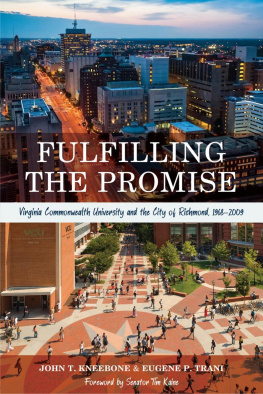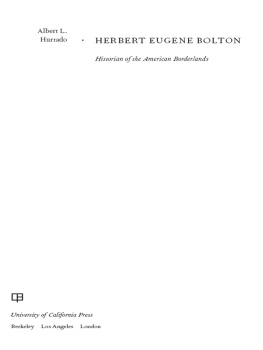University of Virginia Press
2020 by the Rector and Visitors of the University of Virginia
All rights reserved
Printed in the United States of America on acid-free paper
First published 2020
ISBN 978-0-8139-4482-1 (hardcover)
ISBN 978-0-8139-4483-8 (ebook)
987654321
Library of Congress Cataloging-in-Publication Data is available for this title.
Publication of this volume was supported by Virginia Commonwealth University. All authors royalties resulting from this publication will be paid directly to the VCU Foundation.
WHEN I MOVED to Virginia to get married in 1984, Richmond was losing population to surrounding suburbs and was generally cited as one among many examples of American central cities in decline. Frustration with a lack of progress in our city led me to begin my career in elected office ten years later when I sought a seat on the Richmond City Council. My councilmanic district included the main academic campus of Virginia Commonwealth University, as well as many neighborhoods adjoining the university. And so I began what has now become a quarter century in public lifeat the local, state, and federal levelswhere I have observed, represented, and partnered with VCU.
I worked with VCU to cooperate with surrounding neighborhoods who have felt both threatened and excited by the universitys dynamic growth. I helped the city collaborate with VCU to build an engineering school, biotech research park, and major sporting arena. I assisted VCU with ambitious efforts to expand its hospital campus and medical school. As a senator serving on the Health, Education, Labor and Pensions Committee, I am in frequent contact with VCU over national health and education policy, and VCU professors testify often before our committee on a myriad of topics.
I have also seen VCU in the life of my constituentsthe college students attending classes, the community leaders who hash out the details of development plans so that VCUs presence can complement their own efforts without swamping them, the neighbors who work for the university, the area residents who benefit from the top-notch research hospital right in the heart of our city, the friends who pack the Siegel Center to cheer on the VCU Rams. And the university is personal to my familyall three of my children were born at the VCU hospital.
So I am not a disinterested party as I offer introductory thoughts on John Kneebone and Eugene Tranis history of VCUs progress from 1968 through 2009. I have seen it, participated in it, and benefited by it.
Let me get to the punch lineRichmond is a dramatically different city in 2020 than it was in 1984. We are not shrinking, we are growing. We are not aging, we are getting younger. We are not a backward-looking southern museum piece; we are a dynamic, forward-focused city. We are not economically stagnant; we are a hub of innovation. We are not culturally staid, we are creative and diverse. We are not a city of decaying brownfields or razed urban renewal projects; we are a community with uniquely preserved natural beauty and a carefully tended built environment.
We used to make top 10 lists only for tragedies like our homicide or violent crime rates. Now Richmond is celebrated often for its achievements, quality of life, natural beauty, and cultural vibe. We have our problems, to be sure. But we have had enough success in overcoming obstacles that once seemed insurmountable that we have developed a renewed sense of pride and confidence that we can overcome any challenge before us.
As I think about the trends that have led to a powerful transformation in Richmond during the last decades, the three that seem most obvious to me are the progress of VCU, the desire of our citizens to break out of long-standing patterns of discrimination, and the concerted effort by so many Richmonders to reclaim, preserve, and promote our citys natural beauty, particularly our proximity to the James River. Fulfilling the Promise tells the story of the first of these fundamental pillars that have produced such success.
The history told here is that of the first forty years of VCUthe product of a 1968 merger between the Medical College of Virginia (founded in 1838) and the Richmond Professional Institute (founded in 1917). It is actually multiple storieshow the two institutions came together to become one, how the newly founded VCU served its student populations, how VCU interacted with Virginia state government, how VCU interacted with the city of Richmond and its diverse neighborhoods. And the storywhile particular to VCUis also an exemplary story of how an urban university strives, struggles, and succeeds in its quest to educate young people and contribute to the broader economic and cultural life of a metropolitan area.
The book will be most appreciated by university leaderspresidents, administrators, board membersand VCU alumni. But reading it, I am struck by how much value it has for elected officials, state budget officials, and urban planners. The most vivid stories are about VCUs external relationswith policymakers, planners, neighborhood leaders, the business community, the media. I have been active long enough to see VCU make missteps in these relationships, but then learn and improve. The fact that Richmonds recent successes have been so connected with VCUs growth is a tribute to the universitys understanding that the complex web of relationships needed for the success of an urban university cannot be taken for granted or delegated down. And it is also a two-way streetstate and local policymakers, along with Richmond private sector leadership, have grown in their appreciation for the role that VCU plays in our metropolitan area and Commonwealth.
And VCU has played a role in the other developments that have hastened Richmonds successes. The diverse student body and faculty, with many VCU graduates choosing to stay in Richmond, has helped our city embrace beautiful differences rather than cling to an artificial aristocracy of white privilege that so defined us for so long. And the universitys commitment to environmental education has been part of our citys rediscovery of our natural assets as defining features to be cherished.
I applaud Gene Trani and John Kneebone for telling this story so well. And I applaud Gene Trani, and so many others, whose advocacy for VCU has added such positive momentum to my hometown, a city with a magnificent and turbulent past, whose future is brighter because of VCU.
TIM KAINE
AS THE TITLE declares, this book tells a success story, albeit one not unique to Virginia Commonwealth University, the subject of this history. Rather, VCUs history parallels general developments in American higher education and, specifically, the fall and rise of urban universities. Colleges and universities in cities, serving commuter students and engaged through teaching, research, and service with their communities, have become the norm for higher education in the United States. Going to college in the city seems so normal now, writes historian Steven J. Diner, that its difficult to comprehend that it once represented a radical shift not only in the location of universities, but also in their ideals. Leaders of higher education and the general public both long believed that schools in rural locations with bucolic residential campuses better served the character building they perceived as the center of normal college life. For example, Richmond College, now the University of Richmond, relocated after the Civil War to a site just a few blocks west of VCUs present-day Monroe Park Campus, then on the rural edge of the city. The city expanded westward and the college moved again in 1914 to its present campus, a park-like setting away from the city center and a location deemed better suited for higher education.








